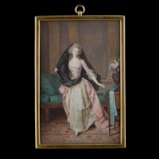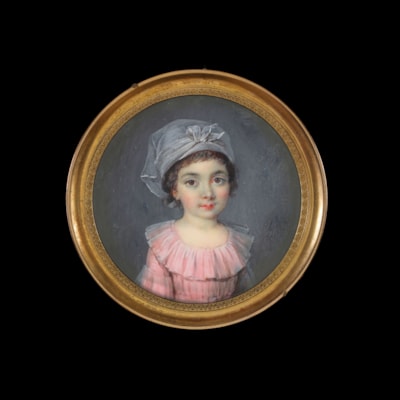NICLAS LAFRENSEN
(1737-1807)Portrait miniature of a Lady, traditionally called Louise Auguste Elisabeth Marie Colette, Princesse de Vaudémont-Lorraine (1763-1832/33), wearing pink satin dress with buckled bodice over white underdress and gauze fill-in, a black veil wrapped around her waist and over her head, she stands in an interior with pilasters, green upholstered chaise-longue and table bearing urn of flowers, a turquoise ribbon about its base
Watercolour on ivory (licence number: F3UZK1YG)
Gilded metal frame, labelled on reverse Princess de Vaudémont. Loraine/ née Montmornecy/ son salon fut célébre sous le 1e Empire/ et la Restauration et assiduement/ frequente par Talleyrand, Narbonne etc/ Ell fut don de cette miniature al mon arriere-grand-once et pere adoptif/ Mathieu Orfila, doyen de la faculte de/ Medecine/ Esp***** Douglas/ du "Serail" de/ Talleyrand; the whole in later fitted leather case
Rectangular, 17.5cm (6 7/8in) high
£25,000
As a noblewoman, she realised her life was in imminent danger at the outbreak of the Revolution, as her friends and family were imprisoned. She fled France for the safety of Altona, Germany in 1791.
While those left behind in France were defined as nobility or as part of ‘the Third Estate’, the Princesse was able to lead a life in Germany where she and her friends held political views which would not have been accepted in the new Republic. By 1800, she was at the centre of the émigré community in Hamburg. As the Comtesse de Boigne’s memoirs attest ‘Altona was a kind of purgatory, where people who proposed to return to France came to prepare themselves for the renunciation of their exclusive principles.’ [1] Alongside her friends, she likely harboured liberal ideas, or at least those ideals which aligned with Philippe d'Orléans, known as ‘Philippe Egalité.’
Under the consulate and the empire, Madame de Vaudémont assiduously frequented the salons, including that of the rue du Bac. Lady Granville described her as ‘uncommonly agreeable, full of new thoughts and strong opinions, cordial and good-natured and as natural as her monkey’.
In control of her own fortune, she was able to afford a 'salon de permanence' that was one of the most significant of the period. ‘Both in her château in Suresnes outside Paris and in her flower-filled hôtel in the rue de Provence near the boulevards, where every room was a garden, she kept open house every day of the year, except on the day she gave a ball for the poor. Her guests, whom she called her conscripts, included- as well as the Corps Diplomatique- Wellington, Richelieu, Pasquier and Count Rostopchine. Talleyrand often sat in a corner, playing with his cane, breaking his silence only to lash out with a well-prepared epigram against the enemy of the moment’.[2]
The influence and draw of the salon is borne out in the recollections of Joseph Orfila, a young doctor who was a frequent visitor: ‘I have obtained more advantageous decisions for the Faculty, I have succeeded in more projects relative to research, in salons than in the proceedings of commissions and in government offices’ and ‘The attraction which this salon had for me was such that it completely absorbed me and I almost never left my home except to go there’.
During his second sojourn in Paris (where he has settled in 1774) the Swedish-born miniaturist Lafrensen established his reputation with small-scale genre subjects depicting elegant figures in interiors or parkland, a continuation of the tradition of Pierre Antoine Baudouin (1723-1769).
Even if compositions represented a single figure, which was not often the case, they were conceived as subject pieces rather than specific portraits. This is emphasised in the titles given- ‘l’accord parfait’ (a man seated in a woodland) and ‘le consolation de l’absence’ (a lady seated and contemplating a miniature). The present miniature is therefore unusual for the period in that a specific portrait, more usually rendered as a bust or half-length, has been executed in full-length and, as a consequence, fuses the two different genres. Upon Lafrensen’s return to Sweden, circa 1790, he reused this innovative format for portraits of King Gustaf III and Sophie Hagman (both Nationalmuseum, Stockholm) and the Sparre family (Öfedskloster).
Having been widowed in 1812, Madame de Vaudémont died in Paris, on the night of December 31, 1832. This portrait, likely painted shortly before her escape to Germany, may have been left behind with family or friends in France to remember this vivacious and politically edified woman.
[1]Memoirs Of The Comtesse De Boigne (1781-1814); Edited From The Original Ms. By M. Charles Nicoullaud, published 1907, p.183.
[2] Philip Mansel, Paris Between Empires 1814-1852, 2001, p. 132
Private Collection UK until sold at;
The Albion Collection, Bonhams, London, 22 April 2004, lot 86;
Private Collection, UK.

shipping notice
Worldwide shipping is included in all prices.
The Limner Company does not accept any responsibility for import duty, this is to be paid by the buyer.
Some stock items contain materials from endangered species which are governed by CITES regulations and will require a permit to export outside of Great Britain. If a certificate of export is required then this will be the responsibility of and paid for by the buyer .
you may also like



 +44(0)7983510056
+44(0)7983510056











